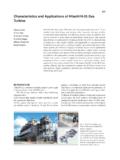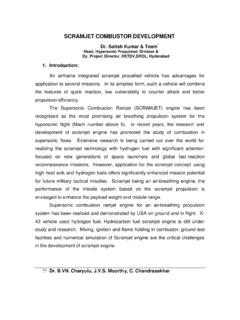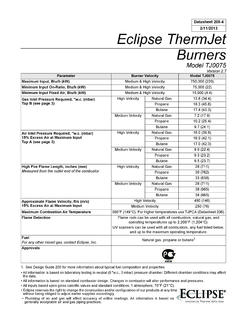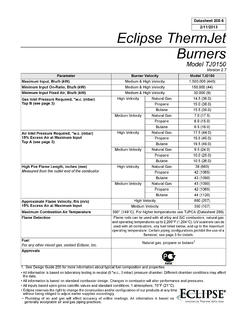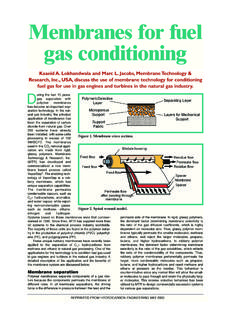Transcription of Emission Standards for Stationary Sources
1 Dr. Miriam Lev-OnInternational Affairs Committee, A&WMABAQ 2010 Singapore, 9 11 November 2010 Breakout Session: Energy Efficiency and emissions from IndustryEmission Standards for Emission Standards for Stationary Sources Stationary Sources An OverviewAn OverviewBAQ 20102 Pillars of Stationary Source Pillars of Stationary Source Emission ControlsEmission ControlsSource Specific & Sector-Based StandardsNational, Regional, Laws and RegulationsNational Scale Air Quality AssessmentsTraining, Education & OutreachBAQ 20103 Control Strategies: Control Strategies.
2 Menu of ApproachesMenu of Approaches Legally binding Emission Standards Energy efficiency requirements Mandatory industrial fuel Standards Operational restrictions via permitting Imposition of work Standards including inspection and maintenance Public-private partnerships and signing of voluntary agreements with industry sectorsBAQ 20104 General Considerations When General Considerations When Devising Emission LimitsDevising Emission Limits Magnitude of the Air Pollution problem Ambient air quality targets defining clean air Applicability to new or existing installations Threshold capacity and/or throughput for inclusion Comparability of processes or methods of operation used successfully on an industrial scale Time needed to implement best available techniquesBAQ Air Quality Planning Air Quality Planning Process Federal legislation with local implementation Federal government provides policy frameworks State governments implement programs under national guidance The two levels of
3 Government share enforcement responsibilities Advantages Allows states to account for each state s unique conditions Encourages experimentation with new policies and programs Disadvantages Creates a complex collection of environmental policies Process may be slow, bureaucratic, and cumbersome Lack of direct accountability to the national governmentStates are accountable for attaining National Ambient Air Quality Standards (NAAQS) through their State Implementation Plan (SIP)BAQ Key Indicators Key Indicators TrendsSource: EPABAQ 20107 Trends of Number of Days AQI > 100 Trends of Number of Days AQI > 100 Source: EPABAQ 20108EU Air Quality Planning ApproachEU Air Quality Planning Approach EU National Emission Ceilings Directive (NECD, 2001/81/EC) Requires the EU-27 Member States to report annually their emissions and projections Four main air pollutants.
4 SO2, NOX, NMVOCs, and NH3 Legally binding Emission ceilings for each of these pollutants and for each country must be met by 2010 Target ambient concentrations should be within a limit value plus a margin of tolerance Member States must develop a plan or program for meeting the ambient limit values within a prescribed time period Monitoring requirements Ambient air quality monitoring Continuous monitoring (or frequent sampling) of Stationary Emission sourcesBAQ 20109EU States SOEU States SO22 emissions emissions Vs.
5 2010 Emission CeilingsVs. 2010 Emission CeilingsProjected EU-27 SO2emissions are 27 % below the ceiling ofthe NECD for the EU-27 as a wholeSource: EU EEABAQ 201010EU States NOx emissions EU States NOx emissions Vs. 2010 Emission CeilingsVs. 2010 Emission CeilingsProjected EU-27 NOx emissions are 16 % above the ceiling ofthe NECD for the EU-27 as a wholeSource: EU EEABAQ 201011EU States NMVOC emissions EU States NMVOC emissions Vs. 2010 Emission CeilingsVs. 2010 Emission CeilingsProjected EU-27 NMVOC emissions are 5 % above the ceiling of the NECD for the EU-27 as a whole Source: EU EEABAQ 201012US vs.
6 EU Air Quality Planning US vs. EU Air Quality Planning Key Differences The US is a decentralized system of state governments with a powerful national government providing oversight The EU is a decentralized system of sovereign nations with a consensus-based commission consisting of representatives from the national governmentsKey Challenges Overly prescriptive programs may stifle innovation, while programs that are too flexible may not ensure attainment of Clean Air The state planning process can be overly bureaucratic and lacking proper resources and emphasis on innovation and tracking progressFocus on individual pollutants makes it difficult to consider multi-pollutant approaches that may be more effective, both in terms of air quality improvements and compliance costsBAQ Federal Emission Federal Emission Standards New Source Performance Standards (NSPS)
7 -new construction or major modifications Compound specific Emission performance Standards and work practices National Emission Standards for Hazardous Air Pollutants (NESHAP) new and existing industry sectors facilities emitting one or more of the 187 air toxic compounds listed in the clean air act Sectoral performance Standards for listed compounds, surrogates, and work practices Maximum Achievable Control Technology (MACT)for new and existing major Sources Generally Achievable Control Technology (GACT)for new and existing area and urban sourcesBAQ EPA New Source EPA New Source Significant Emission Rates (SER)Significant Emission Rates (SER)7 Sulfuric Acid Mist50 Municipal Solid Waste Landfill Emissions3 Fluorides40 Municipal Waste Combustor Acid Waste Combustor Metals40 (VOCs or NOx) x 10-6 Municipal Waste Combustor Organics15PM 1010 Reduced Sulfur Compounds (Including H2S)
8 40 Sulfur Oxides10 Total Reduced Sulfur (Incl. H2S)40 Nitrogen Oxides10 Hydrogen Sulfide (H2S)100 Carbon MonoxideSER (tpy)PollutantSER (tpy)PollutantBAQ States Emission States Emission Controls State and local control measures Included as part of the State Implementation Plan (SIP) to attain clean air targets Use a menu of approaches including RACT: Reasonably Available Control Technology BACT: Best Available Control Technology LAER: Lowest Achievable Emission Rates EPA maintains a clearinghouse with case-specific information on the "Best Available" air pollution technologies Share knowledge among the States Address mainly controls of the emissions of SO2, NOx, and VOCBAQ 201016 Select New Source Performance Select New Source Performance Standards for Combustion SourcesStandards for Combustion Sources by volume at 15% oxygen on a dry basis of gases emitted.
9 Or fuels that contains sulfur by weightGas or LightFuel OilHeat input capacity > 10million BTU ( GJ)/hour Stationary gas percent by volumeNot specifiedPrimary smelters (zinc, lead, or copper) 544 grams/million BTU Controlled to 90% below potential concentration, or 272 grams/ million BTU Controlled to 50% below potential concentrationCoal 100 million BTU/hour 10 million BTU/hourMid-size Industrial boilers 363 grams/ million BTU Controlled to 90% below potential concentration Oil 544 grams/ million BTU Controlled to 90% below potential concentrationCoal> 100 million BTU/hourLarge Industrial boilersSO2 Limit ValueFuelHeat Input CapacityStationary source type BAQ 201017EU IPPC DirectiveEU IPPC Directive Integrated Pollution Prevention and Control Directive
10 (2008/1/EC, 15 January 2008) Includes measures to prevent or to reduce emissions in the air, water and land Public information on the operation of installations, their potential effect on the environment, and applications for permits for new or substantially modified installations Emission limit values to be based on the best available techniques, No specification of prescribed techniques or technology Consideration of the technical characteristics of the installation concerned, its geographical location and local environmental conditions.
